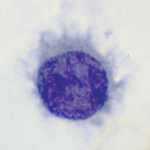Hairy cell leukemia
| Classification according to ICD-10 | |
|---|---|
| C91.4 | Hairy cell leukemia ICD-O 9940/3 |
| ICD-10 online (WHO version 2019) | |
The hairy cell leukemia is one of the low-grade B-cell - non-Hodgkin's lymphoma . The disease got its name from the characteristic fringed runners (hair-like cytoplasmic processes) that can be seen microscopically on the malignant cells ("hair cells").
Epidemiology and causes
Hairy cell leukemia is a rare disease, accounting for around 2% of all leukemias . The median age at diagnosis is 52 years, the male gender clearly predominates (ratio 4: 1). The causes for the development of hairy cell leukemia are largely unknown.
Symptoms
-
Pancytopenia due to diffuse bone marrow infiltration and marrow fibrosis
- Anemia with tiredness and weakness
- Leukopenia with increased susceptibility to infection
- Thrombocytopenia with increased bleeding tendency
- Pronounced enlargement of the spleen ( splenomegaly )
- Enlargement of the liver ( hepatomegaly ) in about 20 percent of cases
- chronically recurring course of Sweet's syndrome
diagnosis
Only about 10–20% of patients have an excessive increase in white blood cells (a leukocytosis ), in the majority the leukocyte counts in the blood are even reduced (in the sense of leukocytopenia ). Nevertheless, the typical hair cells are found in the peripheral blood smear (smear of venous blood ) in most patients. In these cells, or in bone marrow smears can be cytochemical an enzyme , the tartrate -resistant acid phosphatase , detected. The diagnosis is confirmed by a histological and immunohistological examination of the bone marrow.
Differential diagnosis
therapy
The therapy of choice is treatment with the purine analogue cladribine (2-chlorodeoxyadenosine or 2-CdA) by subcutaneous injection. The response rate is over 90% with numerous complete cures ( remissions ). Another purine derivative is pentostatin . Before the introduction of the purine analogs, the disease was treated with interferon -α. Removal of the spleen (a splenectomy ) also leads in many cases to remission with normalization of the blood count , but no longer plays an essential role in therapy due to the very good drug treatment options.
Individual evidence
- ^ Christian Kromer, Michael Peter Schön, Timo Buhl: Sweet syndrome as a harbinger of hairy cell leukemia. In: Deutsches Ärzteblatt. Volume 117, Issue 10, March 6, 2020, p. 176.
